Excerpts from Jim Conrad's
Naturalist Newsletter
from the February 1, 2015 Newsletter issued from Río Lagartos, on the Yucatan Peninsula's northern coast (~N21.60°, ~W88.16°), Yucatán state, MÉXICO
LOGWOOD
Something I looked forward to when coming here was finding the famous tree known as Logwood, HAEMATOXYLUM CAMPECHIANUM -- famous because from the 17th to 19th centuries the tree was logged extensively and exported to Europe for use in dyeing fabrics. I visualized having to stomp through vast swamps to reach rare remaining specimens, but now I see that it's common along the coastal road just south of Río Lagartos. Nowadays it's flowering so spectacularly that it's hard to miss. Below, you can see its bright yellow clusters of flowers amidst dark green foliage:
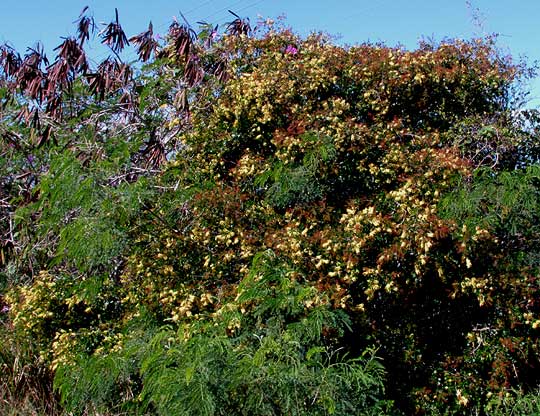
That picture shows how it usually presents itself here -- a compact tree about 15-ft tall tree (4.5m) so enmeshed in low, dense forest that its limbs entangle with, and peek from between, limbs of other trees. Up closer you see that the yellowish flowers are small and densely packed in spike-like racemes, as shown below:
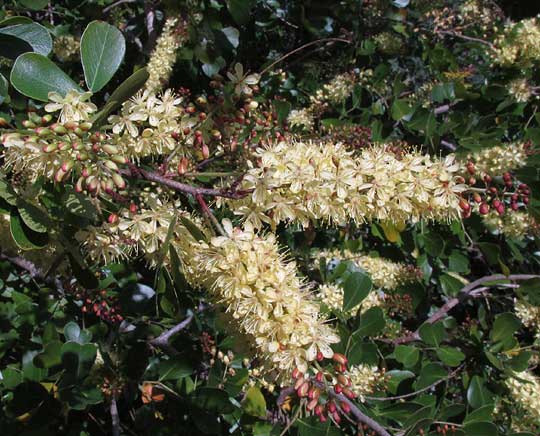
Closer still, the blossom turns out to be a little peculiar, as seen below:
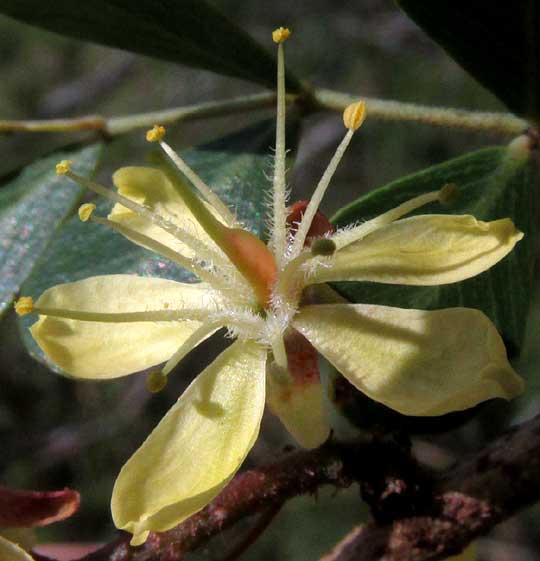
What's unusual is the pinkish ovary in the flower's center. The ovary is lopsided and therefore asymmetrical. It arises inside a whorl of ten stamens with hairy-based anthers, and five petals that seem to be slightly asymmetric themselves, but not much. The corolla's slender tube arises from a cup-shaped calyx. Just looking at the flower, it's hard to say what plant family Logwood belongs to. However, the tree's leaves hint broadly that it's a member of the big Bean Family, as shown beow:
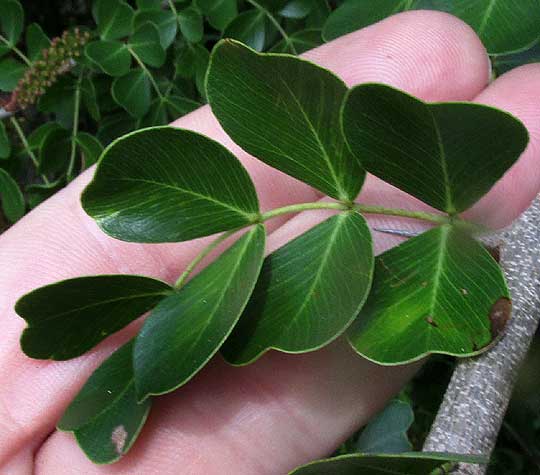
The pinnately compound leaf is similar to several Bean Family members found here, plus notice the woody spine arising at the petiole's base, exactly like several Bean Family species in our thorn forests. Being directed to the Bean Family by the leaves, we think back to the blossom's flat ovary and can visualize such an ovary developing into a flat, legume-type fruit with only one or two beans inside, and that's exactly the case. Logwood is a quirky member of the Bean Family, and its fruits are flattened legumes usually bearing two beans.
One reason Logwood is famous is that it was largely responsible for the foundation of an English-speaking nation down in the Yucatan Peninsula's southeastern corner -- Belize. In the 1650s, the first European settlers in the territory now known as Belize were English pirates and buccaneers known as "Baymen," who settled in such an out-of-the way place trying to avoid the Spanish rulers of Mexico and Central America. The Baymen soon found that they could make good money cutting and selling Logwood to folks back in England, for dyeing fabrics. Just boil in water woodchips of Logwood's heartwood and a reddish dye comes out. Add various chemicals and the dye changes colors. Use mordants, and the dye doesn't wash out too bad. The Baymen's logwood logging camps were the beginning of English-speaking Belize.
Logwood also had a part in causing much of Belize's population today to be black, for slaves were needed to log the trees and ship them out. Eventually Logwood's value as a dye diminished, and logging Mahogany became more important, requiring more slaves and encouraging more Englishmen to come to Belize. This period of Belize's history is related in much more detail at http://countrystudies.us/belize/7.htm.
One thing that article doesn't mention is that Logwood's branches are very spiny and the trunk is extremely dense and hard. Logging these trees in the mosquito-infested swampland they inhabit must have been rough work, and I can hardly imagine what it must have been like for the slaves who did it. A shot of some stem spines is shown below:
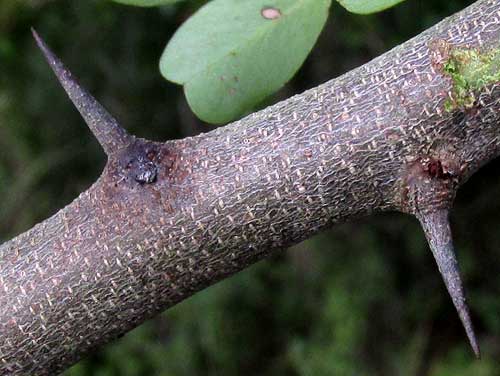
I cut through a twig about as thick as my finger and saw no dye-producing red sapwood in the stem's center. Apparently only the trunk's red sapwood contains the dye and the tree's trunk needs to be hacked into to get it. I just didn't want to hurt the tree to see it. The tree's distinctive trunk is shown, looking like numerous smaller trunks fused together, is shown below:
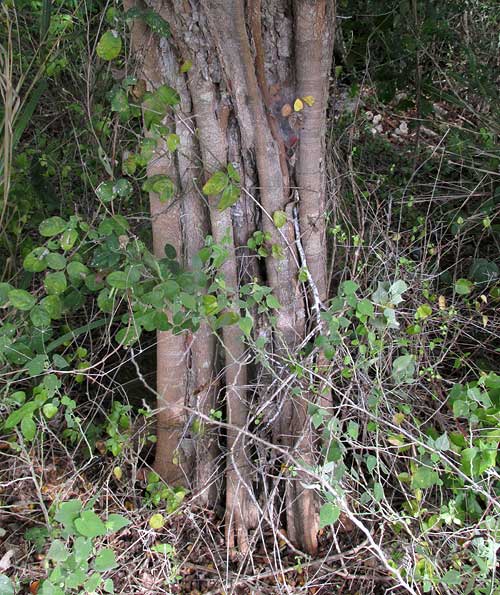
A fine discussion of all aspects of Logwood's use as a dye is found at the UK's WildColours.co.UK website.
Logwood is native to the Yucatan Peninsula, Belize and northern Guatemala, but has been planted in many tropical countries and in some places has become invasive. In it's native lands it's found in flat lowlands with clayey soils, poor drainage, and periodic flooding, but in other countries it does well in disturbed secondary forest, along roadsides, riverbanks, lowland dry forests, urban forests, and seasonal waterlogged areas. In fact, even here it may be most common along roads through the marshes.
from the March 22, 2015 Newsletter issued from Río Lagartos, on the Yucatan Peninsula's northern coast (~N21.60°, ~W88.16°), Yucatán state, MÉXICO
LOGWOOD HEAVY WITH LEGUMES
Nowadays our Logwood trees are as heavily laden with dry, tan-colored, legume-type fruits as they were earlier with flowers. A branch of them is shown below:

As legumes go, Logwood's are unusual for being so extremely flattened and for containing on the average only two beans, sometimes only one, sometimes three. A view of some pods held against the sun so that the beans inside appear as dark spots is shown below
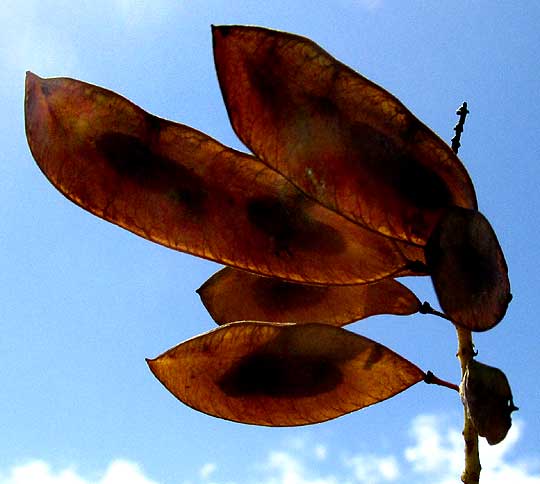
In that picture the bottom-most legume shows yet a third unusual feature of Logwood fruits. Notice the crease-like ridge running across the legume's face from end to end. That's where the fruit will split open so the beans can be ejected. In the big Bean Family to which Logwood belongs, legumes of the vast majority of species open along their edges, not across their flat faces. You can see how the legumes split below:
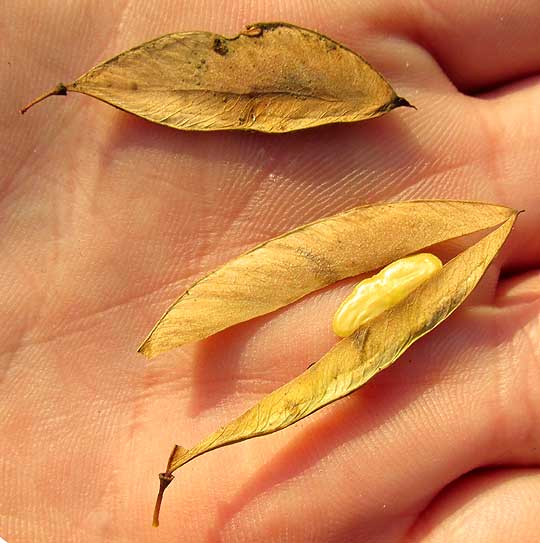
These are peculiar legumes.